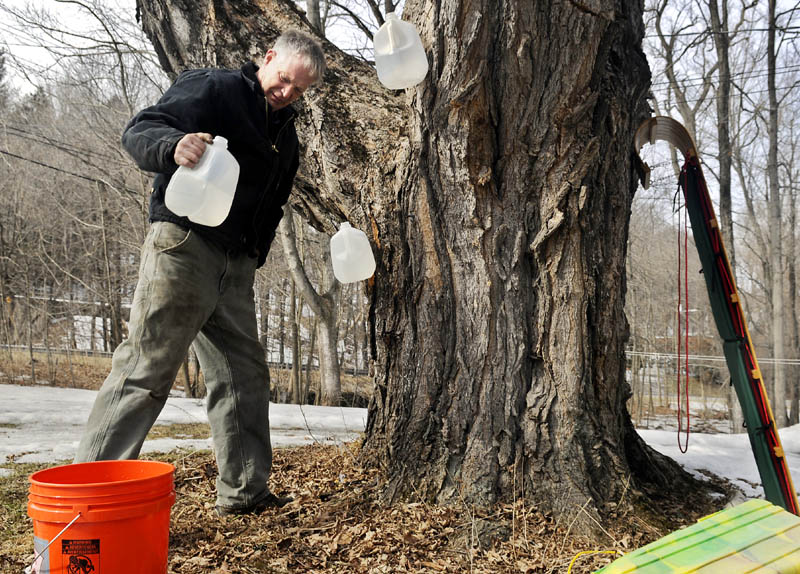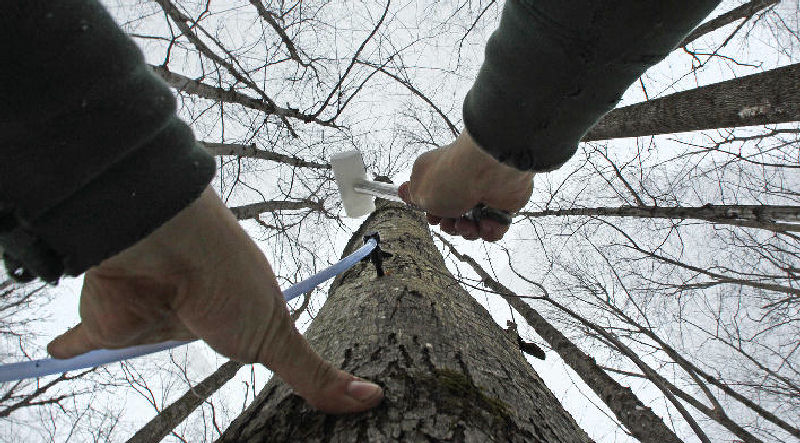MILWAUKEE — Temperatures in Wisconsin had already hit the high 60s when Gretchen Grape and her family began tapping their 850 maple trees. They had waited for the state’s ceremonial tapping to kick off the maple sugaring season. It was moved up five days, but that didn’t make much difference.
For Grape, the typically monthlong season ended nine days later. The sap had stopped flowing in a record-setting heat wave, and the 5-quart collection bags that in a good year fill in a day were still half-empty. Instead of their usual 300 gallons of syrup, her family had about 40.
Maple syrup producers across the North have had their season cut short by unusually warm weather. While those with expensive, modern vacuum systems say they’ve been able to suck a decent amount of sap from their trees, producers like Grape, who still rely on traditional taps and buckets, have seen their year ruined.
“It’s frustrating,” said the 69-year-old retiree from Holcombe, Wis. “You put in the same amount of work, equipment, investment, and then all of a sudden, boom, you have no sap.”
Maple trees generate the most sap when cool days are followed by freezing nights. The flow begins when daytime temperatures creep into the 40s, but in some areas, nighttime temperatures have been warmer than that in the past week. Once trees bud, collection stops because hormones produced in the trees spoil the sap’s taste.
Ben Schultz’s family usually spends about four weeks collecting sap from their 2,500 trees in Athens, Wis. This year, they too stopped after nine days. Instead of producing 350 to 400 gallons of syrup, they made about 165, each one boiled down from about 40 gallons of sap.
“It’s a 70-degree day in March and we’re complaining about the weather while every other Wisconsinite is rejoicing,” the 30-year-old said. “It’s kind of miserable. That’s money out of our pocket.”
Schultz’s family did better than most Wisconsin producers, however, because half of his trees are tapped with a vacuum system. Producers tap trees and insert tubes hooked to a vacuum, which draws the sap out. The systems are effective but expensive, costing about $10,000 on the low end. Suppliers say they’re only cost-efficient for farms with at least 500 trees in a small area. In Wisconsin, the nation’s No. 4 maple syrup maker, most producers are hobbyists who still rely on gravity to pull sap from trees with taps that drain into a bag or bucket.
In Vermont, by far the nation’s leading maple-syrup producer, about three-fourths of farms use vacuum systems, said Timothy Perkins, the director of the University of Vermont Proctor Maple Research Center. He estimated they will make about 60 percent of the syrup they produced last year, while those without vacuums might make 25 percent.
Vermont farms are “doing this for a living,” Perkins said. “They have to make syrup, and the only way you can be sure you’re going to make a decent amount of syrup is to use the newest technology.”
A vacuum system helped Dwayne Hill get 950 gallons of syrup from his 4,500 trees in upstate New York. Typically, he gets 1,500 to 1,800 gallons from his farm in Harpersfield. Overall, Hill, the president of the New York Maple Producers Association, thought the state would produce 60 to 70 percent of the 312,000 gallons it made last year.
“It’s not going to be a full crop, but it’s not going to be a complete bust,” Hill said.
Vermont, Wisconsin, New York and Maine produce about 80 percent of the nation’s maple syrup. While production is down in all four states, industry experts don’t expect big price increases. Henry Marckres, a spokesman for the Vermont Agency of Agriculture, said so much syrup was produced last year — nearly 2.8 million gallons nationally — that this year’s drop would even things out.
“You might see the average price go up 10 percent,” Marckres said. “But that won’t happen for a while.”
Grape predicted prices could rise faster at farmers’ markets and specialty shops, which tend to be supplied by hobbyists more likely to use traditional tapping methods.
Steve Anderson, who sells equipment to maple syrup producers, thought the bad year might convince many to upgrade to vacuum systems. But even if they do, there’s no guarantee of success without the right weather. Anderson usually gets 2,200 gallons of syrup with the vacuum system he has on his farm in Cumberland, Wis. This year he got 400.
“If people were relying on syrup sales to pay for a tubing system, chances are they didn’t make enough money this year to pay for it,” he said.
Send questions/comments to the editors.




Success. Please wait for the page to reload. If the page does not reload within 5 seconds, please refresh the page.
Enter your email and password to access comments.
Hi, to comment on stories you must . This profile is in addition to your subscription and website login.
Already have a commenting profile? .
Invalid username/password.
Please check your email to confirm and complete your registration.
Only subscribers are eligible to post comments. Please subscribe or login first for digital access. Here’s why.
Use the form below to reset your password. When you've submitted your account email, we will send an email with a reset code.